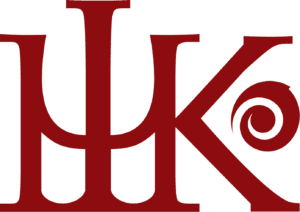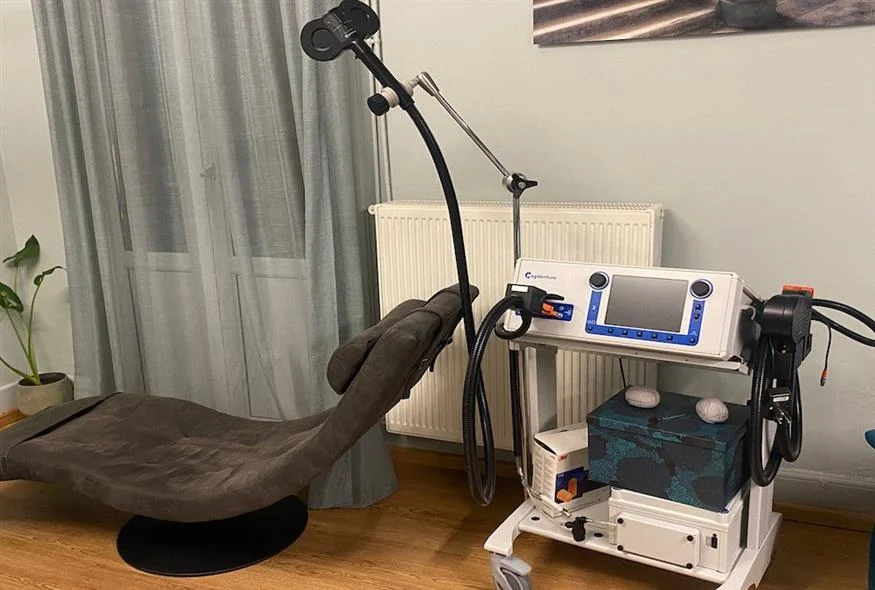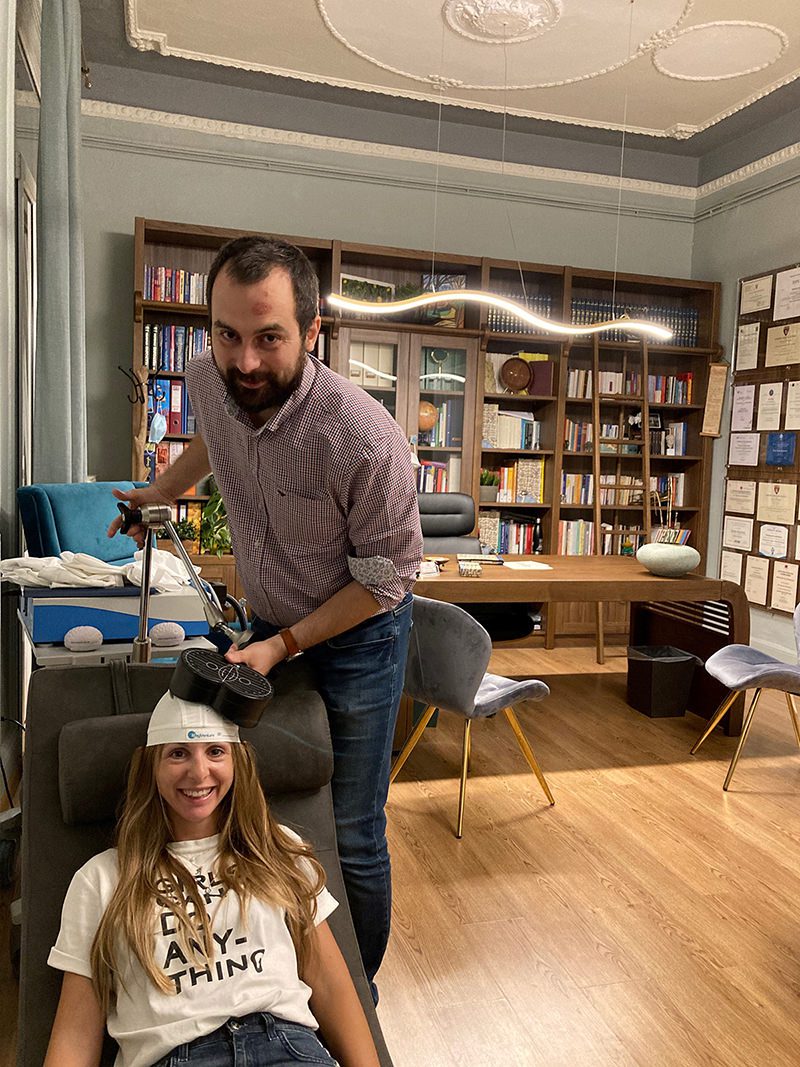
rTMS
Repetitive Transcranial Magnetic Stimulation
-
Depression is real and it starts in your brain. So why aren’t you treating your brain … with Transcranial Magnetic Stimulation?
-
Just 3 minutes a day for a few days.
-
No hospitalization required. This allows you to return to your quality of life.
-
An approved treatment by American and European authorities (FDA, NICE, CE).
-
No medication required.
-
Non-invasive treatment.
-
Comfortable Setting.
-
Advanced Technology.
-
Convenient Location.
-
Highly trained medical staff.
Why do you need rTMS as a therapeutic method?
01.
According to WHO depression is the most disabling diseases in the world and 35 million people suffer from depression worldwide.
02.
According to the World Health Organization (WHO), depression is the leading cause of disability worldwide.
03.
The most common treatment is antidepressants which does not work in many cases and many patients experience side effects such as weight gain, sexual dysfunction, nausea, hyponatremia, dry mouth, sedation, migraine, akathisia, arrhythmias, orthostatic hypotension or hypertension and many other side effects.
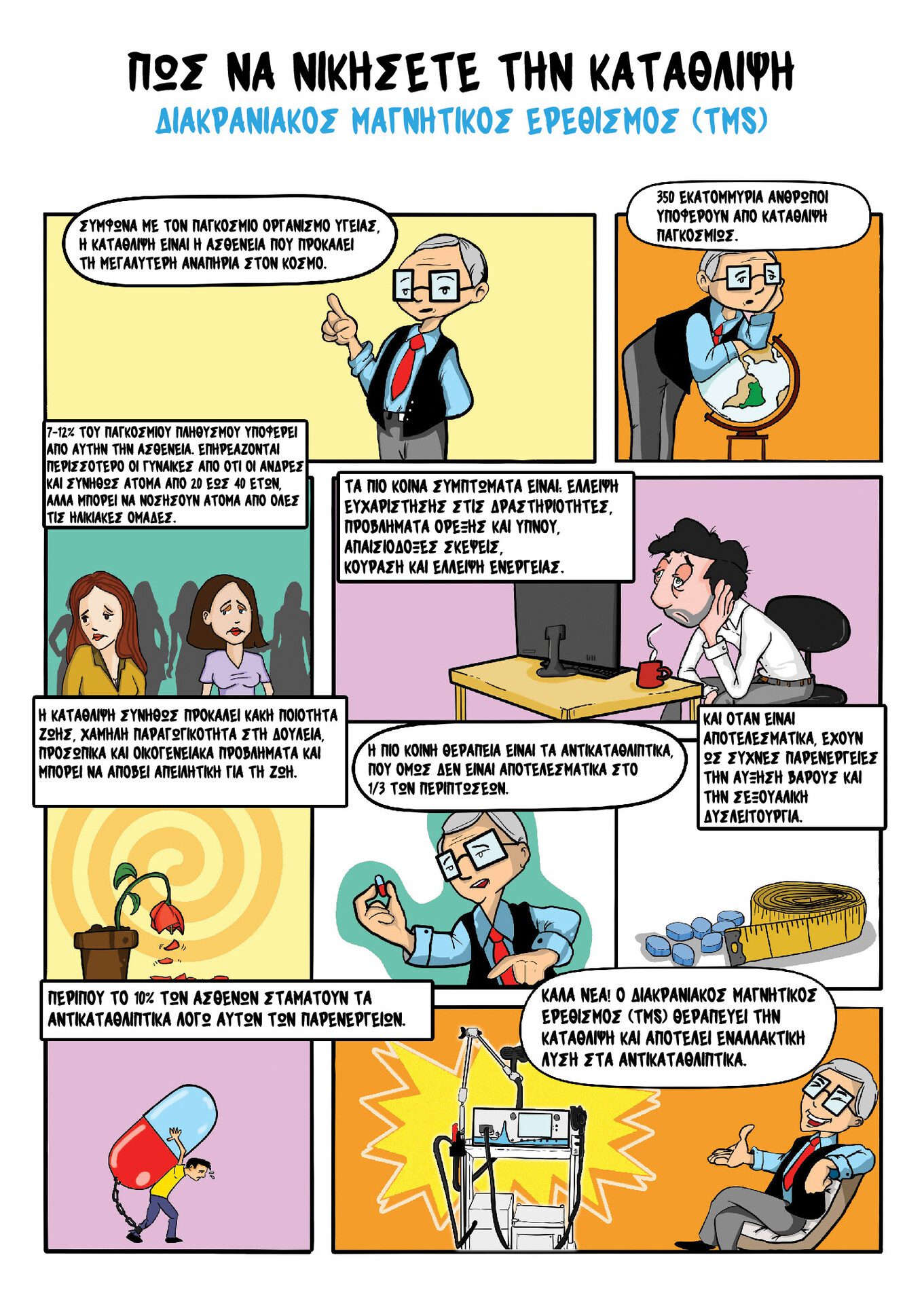
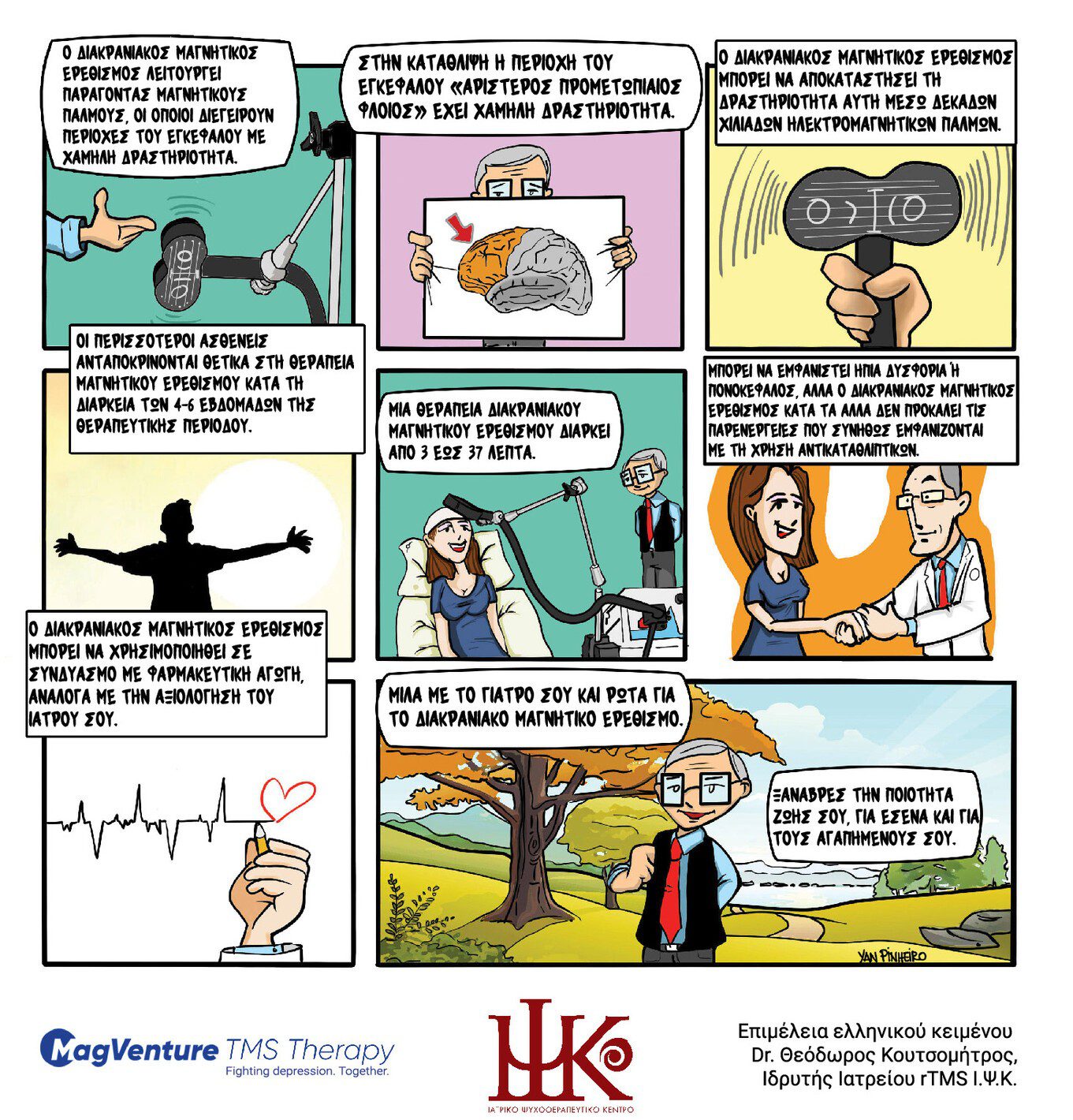
What is Repetitive Transcranial Magnetic Stimulation (rTMS)?
-
rTMS is a non - invasive medical treatment.
-
The TMS coil creates a changing electric field, which in turn induces a magnetic field that passes the skull painlessly.The magnetic field again induces a changing electric field in the brain, which leads to the stimulation of neurons.This locally applied electricity brings the therapeutic results for the treatment of depression and other neuropsychiatric disorders.
-
rTMS is an accepted, evidence-based treatment option by the American Psychiatric Association, the Canadian Network for Mood and Anxiety Treatments, Maudsley guidelines and the World Federation of Societies of Biological Psychiatry.
-
In 2008, it received approval from U.S Food and Drugs Administration (FDA) as a treatment option for patients suffering from treatment-resistance major depressive disorder (MDD) and has been adopted into clinical practice in a growing number of countries worldwide such as: European Union, United Kingdom, Israel, Australia, New Zealand, U.S.A and Canada.
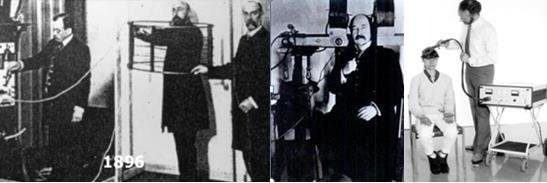
History of TMS
-
The course from discovery of modern TMS to the establishment as a treatment in clinical practice has been a long road. Followed by the discovery of electromagnetic induction by FarEday and Henry in 1831 it was now possible to stimulate the nervous system painlessly by exposing patients to changing magnetic fields.
-
The first successful attempts achieved within the time period of 1896-1910 by d’Arsonval , followed by Beer and Thompson . The difficulty now was in the creation of high intensity current and rapid change of a field so as to induce a physiological activity in the brain.
-
In 1985, Dr Barker et al in Nottingham in UK finally succeeded to develop the stimulators that could produce the required discharge to generate a magnetic field capable to induce current in the cortical tissue. This achievement was the beginning of the use of modern rTMS in brain research and clinical practice.Dr Barker was awarded for his discovery and recognised internationally, almost 30 years later from the development of the first modern TMS machine.
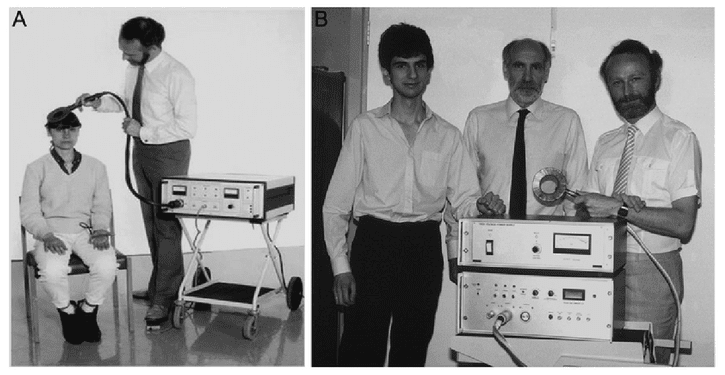
Is rTMS suitable for everybody ?
As you can see we have some absolute and relative contraindications. The absolute contraindication are any ferromagnetic foreign body within 10cm distance from the coil and cochlear impacts.
The relative contraindications are:
-
History of epilepsy
-
Unexplained syncope episode
-
Implantable cardiac defibrillator
-
High GABA load
-
There are no known risks in pregnancy. There are no additional risks in children younger than 18 years old
Safety and side effects of TMS
rTMS is a safe medical treatment. The International Federation of Clinical Neurophysiology has revised their guidelines in 2020.
Common side effects are a transient headache or neck pain that are easily managed with paracetamol, if needed. The acoustic trauma can be prevented for both the patient and the TMS operator by using earplugs. Having said that safety issues are rarely addressed for operators who are exposed to magnetic field several hours every day for years by performing TMS. Guidelines for occupational levels of exposure to electromagnetic fields have been proposed by the International Commission on Non-Ionizing Radiation Protection and by a Directive from the European Parliament.
The rare side effects of TMS are seizure, fainting, dental pain, and hypomanic episode. In Greek rTMS, where I practise TMS and we have seen hundreds of patients I have seen only 1 patient with hypomanic episode so far and none has experienced seizure. Considering that each patient is usually getting 20-30 sessions the estimated seizure rate is less than 0.1%. So some antidepressants have higher risk to cause seizure than TMS, although they are both rare.
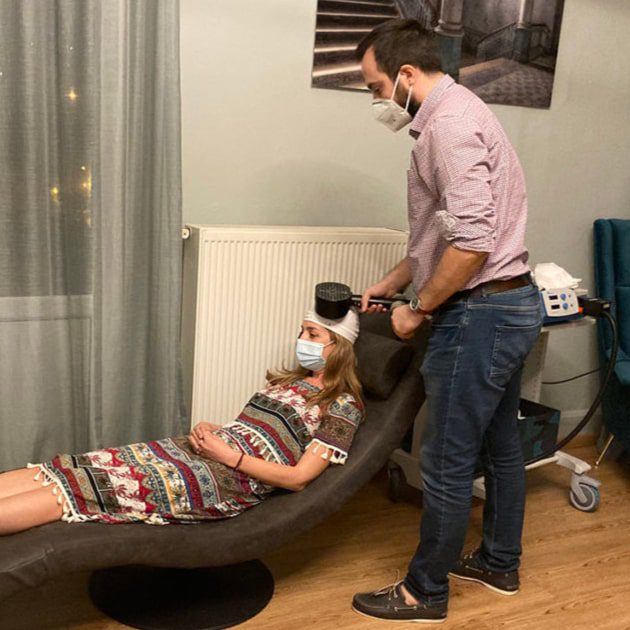
Current list of the TMS indications in Psychiatry & ICD10 codes.
-
Depressive episode (F32) including postpartum and peripartum
-
Recurrent depressive disorder(F33)
-
Bipolar affective disorder (F31.3-5)
-
OCD: Obsessive- Compulsive Disorder (F42)
-
Mental and behavioural disorder due to use of Cocaine (F14)
-
Mental and behavioural disorder due to use of other Stimulants (F15)
-
Mental and behavioural disorder due to use of Tobacco (F17)
-
Comorbid Anxiety Disorders (F41)
-
Migraine (G43)
The first FDA approved indications in 2008 was Resistant Depression but since then the number of studies and evidences has grown exponentially and therefore more disorders are now either FDA or CE approved.
So TMS is now approved for treatment of depression , unipolar or bipolar, with or without comorbid anxiety as well as OCD. In March 2020 FDA granted a TMS device breakthrough designation for bipolar depression. During the last years it also received approvals for several addictions such as cocaine and methamphetamine and smoking cessation.
The following 4 indications as well as many others, such as in the autism spectrum or in pain disorders such as fibromyalgia, do not yet have official approvals but have been applied research for decades with promising results:
-
Schizophrenia, auditory hallucinations(F20)
-
Mental and behavioural disorders due to psychoactive substance use (F10-19)
-
Eating Disorders (F50)
-
PTSD: Post Traumatic Stress Disorder (F43.1)
Have questions? Get in touch with us.
Procedure of rTMS therapy
01.
rTMS is a series of treatments.
02.
Each treatment depending on the protocol lasts from 3min to 37min.
03.
The frequency varies depending again on the protocol but usually there are 5 daily session per week.
04.
Number of treatments also varies depending on the patient's condition and the protocol. In depression protocols the duration of treatment is 4-6 weeks, ie usually 20 to 30 sessions. Treatment of obsessive-compulsive disorder with rTMS consists of 29 sessions lasting 18 minutes each. Finally, rTMS treatment for substance use, such as cocaine, consists of 34 sessions lasting 12 minutes each.
05.
Recently at Stanford University in the USA, colleagues studied a large sample of people with persistent depression who did 50 intensive rTMS sessions in just 5 days with spectacular results and 90% recession rates, which is the most effective so far for the treatment of persistent depression. More information about SAINT-TRD: Stanford Accelerated Intelligent Neuromodulation Therapy for Resistant Depression can be found at the following links:
Stanford Medicine
SAINT-TRD
Below you can see the different rTMS protocols that have been approved for depression in Europe, USA and Canada. The approval that changed the history of rTMS worldwide was that from the USA Food and Drug Administration (FDA) in 2008.
Targeting brain areas of rTMS
The rTMS coil, depending on the brain area that is placed, has the corresponding therapeutic effects on the target neurotransmitters. More specifically, as shown in the figure below, the areas targeted for treatment with Transcranial Magnetic Stimulation are:
-
DLPFC: DorsoLateral PreFrontal Cortex, depression and cognitive rehabilitation , 2007:O’Reardon , 2012: Fox et al
-
DMPFC: DorsoMedial PreFrontal Cortex, depression with prominent anhedonia, 2014:Downar et al
-
TPA: TemporoParietal Area, auditory hallucinations in schizophrenia, 2003:Hoffman et al
-
SMA: Supplementary Motor Area, obsessive compulsive disorder 2018: Lusicic et al
-
Insula (Island of Reil) : anorexia nervosa , smoking cessation
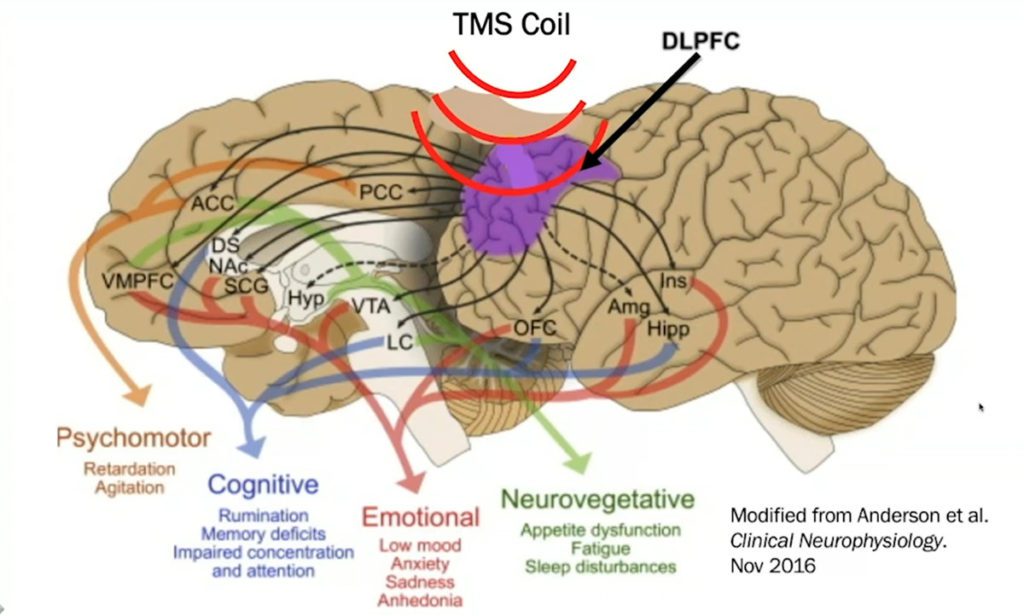
The most studied brain area is the DorsoLateral PreFrontal Cortex..
You can see a schematic representation of the effects on network TMS, showing how targeted
focal TMS stimulation of the central executive network in the DLPFC modulates activity in other
networks and anatomical parts of the brain for the treatment of depression. Thus, by stimulating at a focal point the Left DLPFC , TMS induces dynamic changes throughout the brain networks. Solid arrows represent direct connectivity and dashed arrows represent indirect or sparse connectivity.
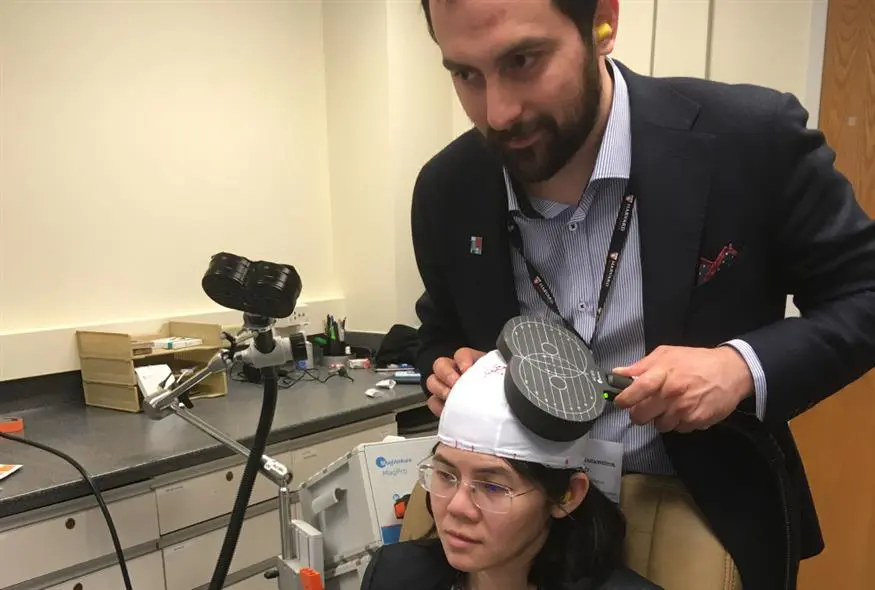
When to refer for rTMS therapy?
-
MDD/Bipolar depression: Outcomes favour rTMS after 1 failed medication trial (STAR*D) Failure of > 2-3 trials more commonly seen due to inconvenience of rTMS.
-
After medications and psychotherapy.
-
Before ECT.
-
Refusal to receive medications.
-
When side effect or adverse effect of antidepressant occur.
-
OCD, PTSD, Eating Disorders: any cases refractory to >1 med trial / therapy are reasonable to refer for rTMS.
